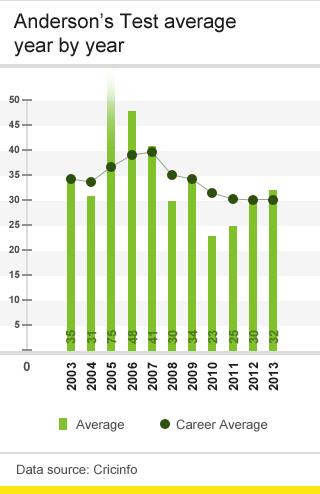England v New Zealand: James Anderson an England role model
- Published
James Anderson glad 300th England Test wicket is 'out of the way'
James Anderson is the best fast bowler England have produced for many a year and is more than worthy of his place alongside Sir Ian Botham, Bob Willis and Fred Trueman in the 300 Test wicket club.
Every now and again a bowler comes along who makes the basics look incredibly easy.
Anderson has a smooth, rhythmical action that is easy to repeat and a perfect upright wrist position that helps him send the ball exactly where he wants.
Anderson reaches England landmark
He reminds me of Sir Richard Hadlee, external and Glenn McGrath, external in the way he effortlessly bowls the ball in the same place time and again, but perhaps his biggest skill is his ability to swing the ball both ways in most conditions.
He is lethal in helpful English conditions when he can move the ball away, but he has also perfected the art of reverse swinging the old ball later in the innings, which makes him a handful anywhere in the world.
When Anderson is bowling, the batsman is being asked a question every single ball and often does not know which way it is going to swing.
I believe he could have got to 300 wickets far sooner had he not been over-coached in the early part of his career.
There was a worry that his slightly unusual action - with his head pointing towards the ground at the moment of release - might be causing damage to his back and for a couple of years he spent more time bowling at traffic cones than he did in the middle.
But, to my mind, his action has not changed much over the years and, as long as he steers clear of injuries, he is more than capable of going well beyond Botham's England record of 383 dismissals.

In many ways, Anderson represents a modern generation of fast bowler. Unlike my generation and the one that followed me, he does not have to play too much cricket to maintain his rhythm, so can focus on staying fit and physically grooved.
He is the role model that any young aspiring fit bowler should aim to follow; if you copy what Anderson does, you cannot go far wrong.
How does Anderson compare with his great predecessors? I am loathe to put them in any kind of rank order because they were all very different bowlers.
Botham swung the ball and could bowl quickly at times but he often got people out through sheer force of personality. He really engaged with the batsman and riled them into trying to get after him.
Trueman may have played in an era of uncovered pitches but his record of 307 Test wickets at 21.57 would be truly outstanding in any era, while Willis was a tall, quick bowler who led the England attack for many years.
Anderson's opening burst put England back on the front foot after they were bowled out for 232 by New Zealand on the second day.
But the tourists fought back gamely, with Ross Taylor playing beautifully for his 66 off 72 balls and Kane Williamson battling hard to reach 44 not out after being reprieved by a very uncharacteristic error by Matt Prior.
It is a fascinating contest that could go right to the wire.
Jonathan Agnew was talking to BBC Sport's Sam Sheringham.
Listen to match highlights and Jonathan Agnew and Geoffrey Boycott's analysis of each day's play on the Test Match Special podcast.
- Published17 May 2013
- Published17 May 2013
- Published17 May 2013
- Published18 May 2013
- Published16 May 2013
- Published16 May 2013